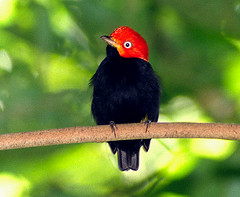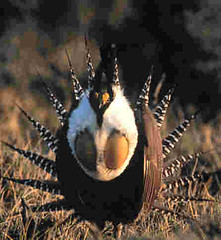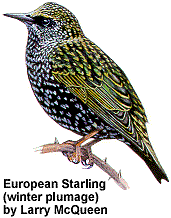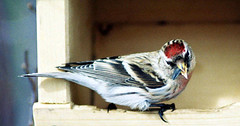Birds in the News #8: Earth Day

Happy International Earth Day! Thirty-five years ago, this day was set aside as a time for dedication and commitment to the care of our planet, and as a time for thanksgiving and celebration. Click here if you would like to learn a little more about Earth Day from one of its founders, John McConnell.
In today's issue of Birds in the News, you will find a story that tells how a scientist discovered how the lovely manakin makes some of its peculiar courtship sounds. This story includes video links and I added sound files so you can watch and hear these sounds for yourself. My "peeps" and I also found a piece that describes how the Colorado State biologists are trying to reverse population declines of the once-numerous Gunnison's sage grouse, and we also found stories about birds that were thought to be extinct that have been recently rediscovered! Also linked are several articles that describe how birds are currently acting as "canaries in the coal mine" for humans, and I linked to an article that describes how the European starling came to America.
As always, dear readers, if you find a bird article that you'd like to share, or you want to contribute photographs to my reader photoblog, feel free to email them to me at grrlscientist at yahoo.
Birds in Science:
 Manakins are brightly colored sparrow-sized birds from the tropical forests of South America. The males have a remarkable courtship display that involves elaborate dances and a "wing pop" that sounds like an electrical discharge. Thanks to the development of super high-speed cameras, the mystery of how a manakin makes his distinctive wing "pop" (click here to hear it) has been revealed, as described in this story, Jungle Dancers. A black and white video of dancing manakins is linked from this site but it is sometimes difficult to view during peak viewing hours in the evening. (The linked sound file and photo are from a male red-capped manakin, Pipra mentalis.)
Manakins are brightly colored sparrow-sized birds from the tropical forests of South America. The males have a remarkable courtship display that involves elaborate dances and a "wing pop" that sounds like an electrical discharge. Thanks to the development of super high-speed cameras, the mystery of how a manakin makes his distinctive wing "pop" (click here to hear it) has been revealed, as described in this story, Jungle Dancers. A black and white video of dancing manakins is linked from this site but it is sometimes difficult to view during peak viewing hours in the evening. (The linked sound file and photo are from a male red-capped manakin, Pipra mentalis.) I found a rather lengthy but basic primer for those who of you are interested to learn more about avian biogeography. If you look carefully at the diagram to the right, you will notice that it is not a modern map of the world but instead, it shows Gondwanaland as it began to break up into pieces and drift away to form the continents and oceans that we are familiar with today. This picture was taken approximately 125 million years ago. [By the way, avian (parrot) speciation, phylogeny and biogeography are my research areas.]
I found a rather lengthy but basic primer for those who of you are interested to learn more about avian biogeography. If you look carefully at the diagram to the right, you will notice that it is not a modern map of the world but instead, it shows Gondwanaland as it began to break up into pieces and drift away to form the continents and oceans that we are familiar with today. This picture was taken approximately 125 million years ago. [By the way, avian (parrot) speciation, phylogeny and biogeography are my research areas.] People helping Birds:
 Due to increased oil drilling in their last strongholds, Colorado State Biologists say it is crucial to reverse the population decline in sage grouse, Centrocercus minimus. Sage grouse may number as few as 142,000 over 11 Western states and the government estimates that there may have been as many as 16 million sage grouse in the Western United States and Canada at one time. Human activities -- increased oil drilling and housing construction, drought, overgrazing by livestock and fire suppression, which appears to favor pinon and juniper trees over the birds' favored sagebrush -- have been blamed for the drop in the bird's numbers. (Click here for video clips and sound files of lekking sage grouse).
Due to increased oil drilling in their last strongholds, Colorado State Biologists say it is crucial to reverse the population decline in sage grouse, Centrocercus minimus. Sage grouse may number as few as 142,000 over 11 Western states and the government estimates that there may have been as many as 16 million sage grouse in the Western United States and Canada at one time. Human activities -- increased oil drilling and housing construction, drought, overgrazing by livestock and fire suppression, which appears to favor pinon and juniper trees over the birds' favored sagebrush -- have been blamed for the drop in the bird's numbers. (Click here for video clips and sound files of lekking sage grouse).Birds and the Environment:
 If you thought that there are a LOT of starlings in the United States, you were right: There are approximately 200 million European starlings, Sturnus vulgaris, in the USA today. These birds are not native to this country, even though people tend to accept them as such because "they've always been here". But we know that all of these birds are the offspring of 80 pairs of European starlings that were introduced into Central Park 120 years ago. These birds provide a powerful warning of the huge impact that a few exotic animals can have on local ecology and native species, as described in this article, the Bard to blame for influx of exotic birds. (Click here to learn more about European starlings.)
If you thought that there are a LOT of starlings in the United States, you were right: There are approximately 200 million European starlings, Sturnus vulgaris, in the USA today. These birds are not native to this country, even though people tend to accept them as such because "they've always been here". But we know that all of these birds are the offspring of 80 pairs of European starlings that were introduced into Central Park 120 years ago. These birds provide a powerful warning of the huge impact that a few exotic animals can have on local ecology and native species, as described in this article, the Bard to blame for influx of exotic birds. (Click here to learn more about European starlings.)Recently, Ecuador designated the Galapagos Islands National Park as an Important Bird Area (IBA). As a result, the government will decide how to deal with longline fishing around these islands, a wide-spread practice that kills albatross, petrels, and other seabirds, and sea animals such as sea turtles. Their decision will have important implications for the recovery of the waved albatross, Phoebastria irrorata, and the Galapagos Penguin, Spheniscus mendiculus, which breed on the Galapagos and are threatened due to longline fishing near the islands. This story includes several pictures of the waved albatross as well as "editor's notes" and contact information for Conservation International-Ecuador and for photo usage.
On this Earth Day, it is a great pleasure to remind you of some good news by pointing you to this progress report; the forest spotted owlet, Athene blewitti (Heteroglaux blewitti) -- believed to be extinct for 113 years -- was rediscovered in 1997. It now is estimated to have a population of 79 individuals. This bird is found freely flying in the forests of Maharashtra, according to the Bombay Natural History Society (BNHS).
More good news: after Angola's civil war ended in 2002, ornithologists and birders were allowed into the country for a look around in February, 2005. They found three bird species that were thought to be extinct as reported in Angola reveals its bird secrets. This story includes a photograph of one species, the orange-breasted bush-shrike, Laniarius brauni, a lovely bird that impales its prey on thorns. "These exciting rediscoveries are welcome news, but illustrate how poorly known the birds of Angola are. Further surveys are urgently needed in order to establish a more accurate picture of the species’ true status and conservation needs," says Dr. Stuart Butchart, Global Species Programme Coordinator for BirdLife International.
Use of DDT, a commonly used pesticide, was heavily restricted in the United States since 1972, when it was shown that it was decimating bird populations. But despite these strict controls, the evidence shows that DDT levels are continuing to increase in non-migratory birds to this day, as described in a concern that won't fly away. Does that spell trouble ahead for these still-healthy species? Are humans at risk? No one knows. But one lesson seems clear: Beware of what you put into the environment, because it can be extraordinarily difficult to remove.
Birds and other animals that display abnormal and bizare behaviors are not as amusing as they appear at first glance. In fact, these animals are a warning that they (and we) are living in an increasingly toxic chemical soup comprised of hormones and their break-down products, of heavy metals such as lead, polychlorinated biphenyls (PCBs), and additives such as bisphenol A, as explained in this NewScientist article, Pollution triggers bizarre behaviour in animals.
Bird Disease:
If you have looked around my blog, you know that I often write about avian influenza (I am finishing three more articles, too). Of course, writing about this topic means that I read vast amounts of primary and secondary literature about it as well. Bird-flu threat: Think globally, prepare locally is one of the better articles I've read recently because provides a nice overview of biosecurity measures taken by a chicken farm in the area, along with the latest CDC information about public health issues and the importation ban on exotic animals.
Are you a bird owner or small-flock bird breeder? If so, you will be interested to know that the U.S. Department of Agriculture's Animal and Plant Health Inspection Service is offering a free DVD or video on biosecurity for bird fanciers and small-flock poultry owners. The 15 minute presentation, part of the department's Biosecurity for the Birds campaign, is designed to help bird owners put in place practices to prevent the spread of diseases such as exotic Newcastle disease and avian influenza, should outbreaks occur in the United States. To order the video, call (301) 734-7799 or email birdbiosecurity@aphis.usda.gov.
Native birds are also suffering from disease in the United States. In fact, bird
 feeders pose a problem when they are not kept clean, so kind-hearted people can in fact be "killing with kindness". This is the case for redpolls, Carduelis flammea (pictured), a small red-capped finch that is a common feeder bird throughout the northern regions of North America. These birds along with several other species, are dying from a bacterial infection, Salmonella, that they get from dirty bird feeders. This article was written by the Wisconsin Department of Natural Resources and it provides good information about proper bird feeder hygiene so people living elsewhere can also protect their birds from harm. (Click here to learn more about the common redpoll. You can click on the redpoll picture above to see a larger image in its own window, too).
feeders pose a problem when they are not kept clean, so kind-hearted people can in fact be "killing with kindness". This is the case for redpolls, Carduelis flammea (pictured), a small red-capped finch that is a common feeder bird throughout the northern regions of North America. These birds along with several other species, are dying from a bacterial infection, Salmonella, that they get from dirty bird feeders. This article was written by the Wisconsin Department of Natural Resources and it provides good information about proper bird feeder hygiene so people living elsewhere can also protect their birds from harm. (Click here to learn more about the common redpoll. You can click on the redpoll picture above to see a larger image in its own window, too). Birds and Politics:
This NY Times story was sent to me by a colleague regarding the outrageous and disgusting hiring practices of the New York City Parks Department. The hiring of this bozo, Thomas Cullen, an expert parrot and raptor smuggler and so-called raptor "expert", to bring Bald Eagles back to Inwood Park is an example of the indefensible hiring practices by New York City's Parks Department. I've said this before about similarly disgusting situations, and I'll say it here again: THIS GUY -- A FELON -- HAS A PAYING JOB working with birds while I remain unemployable! This article requires NY Times registration (free). If you prefer to remain anonymous, you can sign in using "clreader" as your username and password.
Previous : : Birds in the News : : Next
Academic Job Applications: 11 (my last installment of the "shotgun method" of applying for summer adjunct positions that may or may not exist at local universities and colleges: This is my patented "toilet paper campaign" where I send applications to the chairs of all college and university science departments within subway range while simultaneously crossing all my fingers and toes).
Academic Job Rejections: 1 (Assistant Professor of Biology)
© 2004, 2005, 2006 by GrrlScientist











3 Peer Reviews:
I would love a "stiff drink"! It would go well with my "stiff upper lip".
I am glad that you are enjoying the avian bigeography link, too. I was really excited to share it with my readers when I found it.
GrrlScientist
Great post! Seems we have something in common, birds, as I am a caretaker of several parrots and finches.
Oh, wow, thanks for visiting my blog, CE Petro! I am so happy to hear that you too have some birds in your life (life without birds would be barren and sad, in my opinion, hence, these weekly Birds in the News round-ups).
Post a Comment
<< Home